In the relentless pursuit of sustainable practices, while also maintaining or even increasing profitability, industries worldwide are continually seeking innovative solutions to minimize their environmental footprint and show better stewardship of the raw materials used in production. The largely hidden costs associated with the material handling of scrap products are often eye-popping in their true scope and impact in most production settings. Creating greater efficiencies regarding how scrap is handled is one of the prime benefits of any size reduction strategy. One such pivotal player in size reduction technology is the primary industrial grinder/shredder. This blog will delve into the fundamental functions of world class industrial grinders and shredders, shedding light on their indispensable role in mitigating waste across various sectors. It will also illustrate how different size reduction technologies are appropriate for specific applications, as well as how these different technologies can be linked together to tackle some of the world’s most difficult recycling challenges.
The Fundamental Function of Industrial Grinders
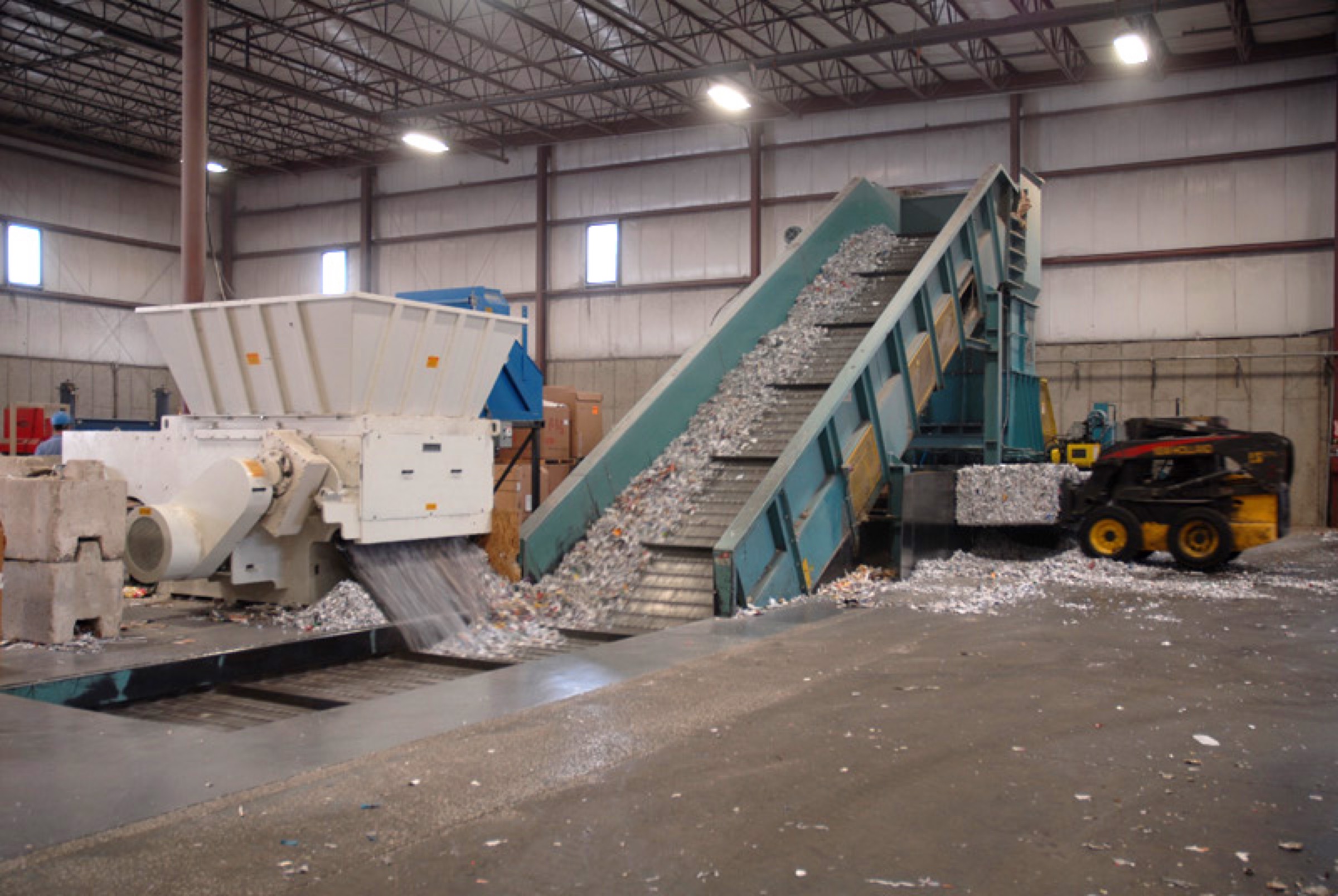
Paper recycling system producing high-quality bales & featuring Cresswood XRV700-150 primary industrial shredder
Industrial primary grinders & shredders are robustly designed machines whose foremost function is to break down relatively large solids, films, containers, packaging, or sheet materials into smaller particles. These versatile tools are equipped with powerful mechanisms, such as blades, hammers, or rotary shears, that efficiently reduce the size of a diverse range of material types. The size-reduction process not only facilitates easier and more efficient disposal, but also unlocks the potential for creating value-added circular economies by recycling, commodification, and eventual reuse of scrap materials traditionally bound for landfills.
The main types of industrial size-reduction equipment are hammer mills, granulators, and shredders/grinders.
Hammer mills are primarily used to grind a wide range of materials into relatively fine powders. They operate at very high RPMs and employ rotating hammers to strike the material and break it into fine particles. The mill is fitted with a screen that acts as a sieve to size the outgoing material to a narrowly defined specification. They are commonly used in the size reduction of wood and plastics, and in the agricultural industry to pulverize grain in the production of animal feeds and base ingredients for human consumption.
Granulators are typically employed to process plastics and rubber materials. These machines use rotating knives to slice material into smaller pieces which are then passed through screens to create a very uniform end-product. They are used frequently in the plastic industry to reclaim scrap by turning it back into a suitable feedstock material for extrusion processing.

PVC pipe scrap – Common form of rigid plastic waste
Recycling shredders/grinders come in the following basic types: Single-shaft, dual-shaft, quad-shaft, screw compactor, and high-speed hoggers. These are very robustly designed industrial equipment that can process a wide range of materials including wood, pallets, paper, corrugated material, plastic film, and rigid forms of plastic like PVC pipe and purgings. In the paper and plastic industries, this equipment is typically referred to as a primary shredder, while in the wood and pallet industries, it is more commonly referred to as an industrial grinder. This size-reduction equipment can be paired with both hammer mills and granulators to create a harmonized recycling system capable of handling a wide variety of scrap geometries and densities with relative ease. A large plastic purging is dense and can easily weigh hundreds of pounds and simply cannot be presented directly to a hammermill or granulator. The same is true of such objects as whole wood or plastic pallets, or large industrial dunnage like crates. Doing so would immediately overwhelm the hammermill or granulator equipment and likely cause significant damage and downtime. These dense and bulky materials must undergo a first-pass size reduction to create the proper feedstock the hammermill or granulator is designed to process. This is an integrated recycling system where the industrial grinder/shredder is referred to as the primary size-reduction process and the hammermill or granulator as the secondary process. A dual or quad-shaft shredder can also be an appropriate choice for primary size reduction in many applications. An industrial shredder/grinder is also generally not capable of producing the types of fine powders, particles, or grains that the secondary processing equipment is specifically designed to produce, meaning both depend on the other for success in a variety of applications.
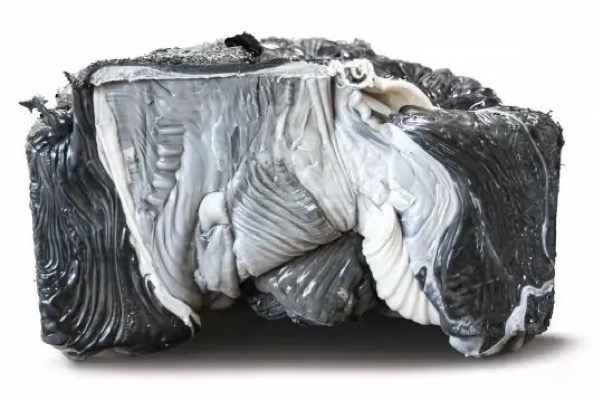
Examples of large plastic purgings waste from extruding process
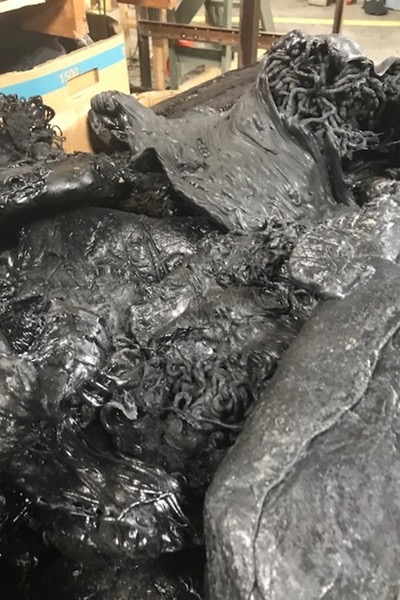
Examples of large plastic purgings waste from extruding process
Specific Challenges in the Paper, Plastic, Pallet, and Wood Industries
Paper Industry

Large bales of corrugate/paper
The paper industry faces challenges related to the disposal of vast quantities of paper waste. This waste can take the form of books/magazines, office paper, corrugated cores, box/packaging materials, label stock, newsprint, and kraft paper/corrugate. Industrial paper recycling shredders are crucial in breaking down bulk waste paper products into manageable sizes, enabling efficient recycling and reducing the environmental impact. Most profitable and efficient paper recycling is focused on creating quality bales out of the recycled product that can be sold on the open market as feedstock. Baling creates the most uniformly shaped and densified end product for waste paper, making it both efficient and profitable to transport and recycle. To produce quality bales, the scrap paper must first undergo a primary shredding process to condition it. So in the paper recycling industry, you commonly find an integrated system composed of a primary shredder linked to an industrial baler via conveyors.
Plastic Industry

Rolls of clear plastic polyethylene (PE) film material
Plastics, notorious for their persistence and adverse impact on the environment, pose a significant and growing opportunity for recycling equipment OEMs. Many types of plastic waste are generally classified into two categories – rigids or films. Industrial plastic recycling shredders are capable of breaking down a wide geometric range of a multitude of plastic polymers into smaller particles, making them easier to process and recycle. This ultimately results in mitigating the detrimental effects of plastic pollution by creating circular economies with the plastic materials we use every day. Common types of rigid plastic include HDPE and LDPE solids, automobile parts like bumpers, consoles, and dashboards, PVC piping, PS or “styrofoam”, or PET in the form of beverage containers. Examples of plastic film would include stretch wrap, grocery/retail bags, bags for agricultural products, films used to cover silage/hay, and boat wrap material.
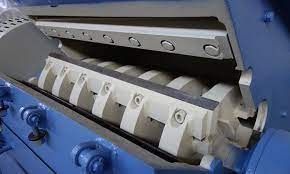
Inner view of granulator showing steel knives used for cutting
These two main types of plastic waste, rigid vs. film, each require a very specific cutting and material handling technology to be successful. Heat buildup and static charge are also crucial considerations when formulating material handling design for a size reduction system. Rigid plastic materials are relatively dense and can easily be moved via conveyors or air systems. Shredded film, on the other hand, has a lot of volume but extremely low density, and creates a lot of static charge when it is processed. This calls for very different forms of material conveyance from what works with rigid plastic materials. You may also see the need for bale breakers, metal separation, and/or roll shears upstream from the primary film shredder to create a functioning and harmonious system with maximum efficiency.
Pallet Industry

Stacks of new block pallets ready for the customer
Wooden pallets, widely used as the most economical and sustainable choice for shipping and logistics, ultimately degrade and contribute to the wood waste stream. Industrial pallet recycling shredders and grinders provide a solution by reducing these degraded pallets and pallet parts from recycling lines into wood chips or fine dust, creating valuable raw materials for various applications like mulch, bioenergy, animal bedding, or composite material for engineered wood products like MDF, OSB, and particle board. Most pallet recycling systems require some form of metal separation to remove the nails and other ferrous material used in the pallet fabrication process. Magnets are deployed to remove the ferrous material from the wood waste, creating yet another recycled material, such as reclaimed steel scrap.
Wood Industry
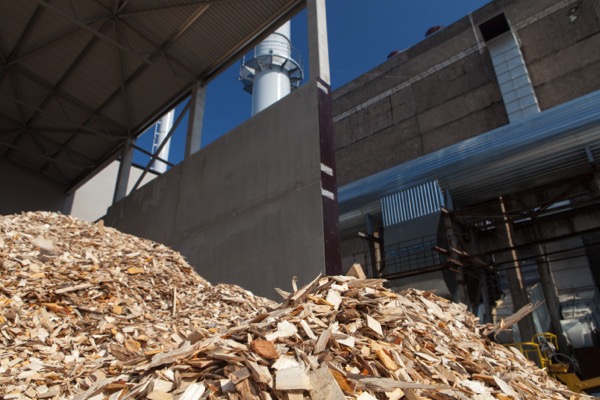
Large pile of miscellaneous wood waste
The wood industry faces challenges in managing wood waste generated during manufacturing processes. This waste comes in many different shapes, sizes, and material types, further adding to the complexity of the challenges. Common types of wood waste include OSB, Particle Board, MDF, hard and soft wood, and plywood. The main driver in pushing woodworking companies to seek a wood recycling solution is the reduction of rising material handling costs. As scrap levels build, it becomes increasingly costly to transport this material around the shop. The difficult labor market has only accentuated the need for more efficiency in material handling. Most of the larger woodworking shops already have a centralized dust collection system for their CNC equipment. By placing grinders at the source (what is commonly referred to as “Zone Grinding”) waste material is vectored directly up and into the dust collection system via air, making what was a costly and labor-intensive pain point virtually “hands-free”. Not only does grinding present substantial labor savings, but it also significantly reduces or even eliminates landfilling and disposal costs. Industrial grinders efficiently process a wide range of wood scraps, transforming some of them into useful by-products like animal bedding, mulch, or biomass fuel.
Addressing Challenges Effectively with World-Class Industrial Grinders

Primary Shredder to Granulator Plastic Recycling System
Identifying the Material to be Processed
Perhaps the most important factor to consider when choosing an industrial grinder is knowing the type(s) of material you’ll need to process. Different materials each have their specific properties and therefore require very specific types of equipment to process successfully. For example, plastics and rubber tend to be soft and relatively flexible, while other materials like wood and metal, tend to be harder and more brittle.
When selecting a grinder, it’s critical to have a clear understanding of the size, shape, and consistency of the material you’ll be processing. This is not a one-size-fits-all type of application! Some grinders are better suited for quickly grinding large, bulky materials, while others are designed for finer, more delicate materials. Choosing the wrong type of grinder can result in inefficient processing, damage to the material, or even severe damage, high maintenance costs, or premature breakdown of the grinder itself.
Volume and Capacity Requirements
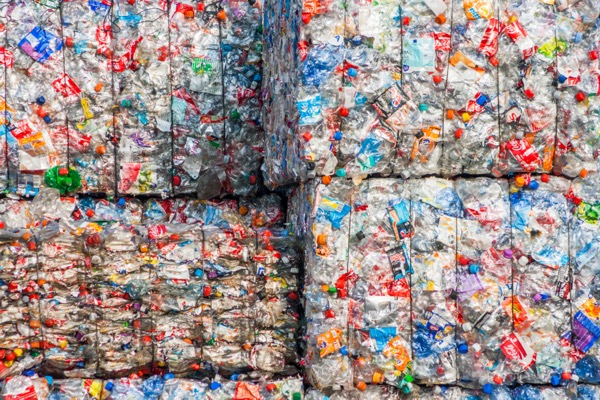
Bales of waste plastic containers requiring recycling solution
The next factor you should carefully consider is the required production capacity of your operation. Will the system be metered or will you be surge-feeding material? Is the material recycled as it is generated, or will an entire shift’s waste all be dumped at once? The equipment in a metered system can be sized very closely to the overall volume requirement, whereas a surge-fed system will require adequate additional material buffers and/or over-capacity rating of the equipment to account for the spikes and still maintain critical daily output averages. Is there a need for redundancy or keeping parts/tooling on hand so that routine PMs and downtime won’t break the system? Industrial grinders come in a range of sizes and screen configurations, specifically designed to process different volumes of material per hour. Be confident you’re choosing a grinder with the ability to keep up with your production needs without being overwhelmed or massively underutilized.
It’s also important to consider the potential for future growth or changes in your operation. If you anticipate an increase in production capacity in the near future, it may be wise to invest in a larger grinder now to avoid the need for costly upgrades or replacements down the line.
Equipment Footprint and Space Constraints
Next, you need to consider the size of the grinder relative to the amount of space you have to work with. Production floor space is often at a premium, so this is something you shouldn’t neglect to think about when deciding on a grinder. Industrial grinders come in a wide range of sizes, from small tabletop models to very large industrial-sized machines. Make sure you choose a grinder that won’t impinge on your workflow and production staging needs.
You should also consider the layout of your facility and identify any obstacles to equipment installation. Another part of thinking about the environment for the grinder is in terms of noise and dust generation. Some grinders produce unhealthy levels of decibels over the OSHA-prescribed limit where a hearing conservation program is legally required, while others do not. There may also be sound mitigation options offered by the manufacturer depending on your needs. High-speed grinders naturally produce relatively high volumes of dust/fines, while lower RPM solutions generally do not. Will the grinder be isolated or will it be close to where operators are working? Is dust mitigation a factor, or will the grinder be located in a remote area where this isn’t a concern?
Energy Efficiency and Cost of Ownership
Operating an industrial grinder can present a significant cost of ownership, both in terms of energy/fuel consumed as well as routine and unplanned maintenance and repairs. When choosing a grinder, be sure to understand the annual energy cost to operate and make comparisons between different suitable options to find the lowest operating cost solution.
Some grinders may be more expensive up-front than their competition, but superior craftsmanship, materials, and design will all provide significant cost savings over time, both in terms of lower overall energy consumption per ton of material produced and/or reduced direct maintenance costs (labor/parts/tooling). To get the best idea of the true cost/benefit of grinding equipment, figure out what your cost per ton of material is when adding up energy consumption, tooling wear, and average annual maintenance costs. Budgetary constraints aside, it is very important to weigh the long-term costs & benefits of your grinder options before settling on a final decision.
Maintenance and Durability
Finally, it is extremely important to always consider the maintenance and repair requirements for any type of grinder you choose. This equipment is often deployed in very tough environments and applications that put tremendous stress on tooling and equipment. These machines will require regular maintenance and tooling rotations to continue operating at peak efficiency. Dull/broken tooling or a damaged screen can quickly turn an effective system into a show-stopping bottleneck.
Make sure you choose a grinder that is built to last and stands behind the equipment with quality service and support options. Some materials are relatively easy for a grinder to process, while others require the most robust designs to operate reliably over time. You should also consider protecting your equipment investment with metal detection and/or separation options if warranted in your application and environment. If tramp metal gets into the mix, it can cause major damage to your grinder, prolonged downtime, or even start a fire. Metal detection on incoming feed conveyors can easily identify problem ferrous material so it can be removed before it gets into the machine. Many grinder manufacturers also offer advanced control options like HMI interfaces and ethernet connectivity. These options are generally quite expensive, but they do allow the equipment to be monitored and troubleshot remotely, as well as enable recording fault modes and sending email alerts to maintenance and engineering personnel.
You should also consider the availability of replacement parts and the time/expertise required to perform routine maintenance and repairs on the grinder. It’s smart to choose a grinder company that ensures a wide inventory of readily available parts, short lead times, and an intuitive user-friendly design that is easy to work on. How-to videos and whether or not the company can provide a factory-trained service technician can help minimize downtime and reduce maintenance costs.
Precision and Efficiency
World-class industrial grinders boast precision engineering, ensuring efficient reduction of materials with minimal energy consumption. This not only enhances productivity but also contributes to sustainable manufacturing practices.
Versatility
The adaptability of industrial grinders to handle diverse materials sets them apart. Whether dealing with paper, plastic, pallets, or wood, these machines can be customized to meet the specific requirements of each industry, promoting a comprehensive waste reduction strategy.
Environmental Impact
Advanced industrial grinders are designed with environmental sustainability in mind. Employing these machines not only reduces the volume of waste but also aids in the creation of eco-friendly by-products that can be utilized in other processes.
Industrial grinders play a pivotal role in waste reduction across various industries, addressing the specific challenges posed by paper, plastic, pallet, and wood waste. By investing in world-class industrial grinders, industries not only enhance their operational efficiency but also contribute significantly to a more sustainable and environmentally conscious future.

Recent Comments